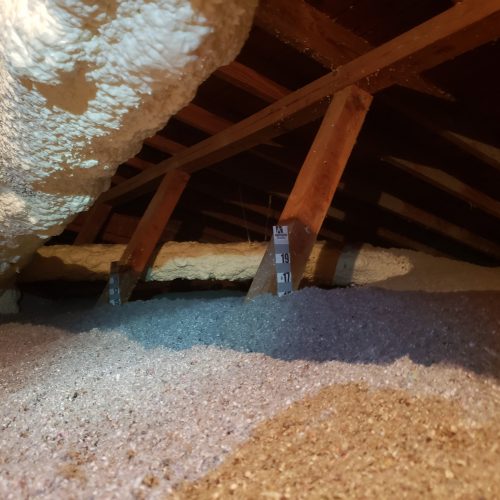I was asked recently, “Bob, what is R value?”
If you’re thinking about how much insulation you need in your attic, you’re probably wondering about R Value.
Bob Explains R-Value
My simple explanation is this: “R value is the measurement of any item to resist the flow of heat through that item.”
Contrast an iron skillet (with a very LOW R VALUE because it readily & easily transfers heat through it), with a block of wood that has a HIGHER R VALUE, because it resists the transfer of heat through it.
The higher the R Value, the greater the resistance to transfer heat through that item or substance.
Minimum vs Recommended R-Value
Currently, in our area of north GA and metro Atlanta, the county code restrictions require a minimum of R-38 for attic insulation.
The U.S. Department of Energy recommends R-49 for attic insulation in these same attics.
So there you have your minimum, and your recommended performance levels for attic insulation: R-38 & R-49.
How we Sell Attic Insulation
Here at Bird Family Insulation we simply round up to R-40 as our minimum, and R-50 as our recommended level for attic insulation. Only twenty cents per ft2 separates them!
Professionals measure R Value in loose fill insulation by how thick (or deep) it is, using a simple measuring tape. In your attic, we staple cardboard rulers throughout, so everyone can see the depth of their fresh insulation.
12” or 15”… it’s that easy!
Different substances have different R-values per inch.
Most new, fresh loose-fill fiberglass insulation has an R Value of 2.2 to 2.9 per inch.
Fresh, new cellulose loose-fill insulation has an R Value of 3.1 to 3.8 per inch.
You see, cellulose insulation has a higher R value per inch than loose fill fiberglass insulation.
We are a cellulose installer. To achieve R-40, we install 12” of cellulose insulation. To achieve R-50, we install 15” of cellulose insulation. Nice, Round Numbers. Easy for you to understand and grasp quickly, to confirm that you received what you paid for!
If we’re installing our Bora Spray cellulose insulation in an attic with existing insulation, we simply add it on top of the old insulation.
As I mentioned earlier, we only charge twenty cents more per square foot to install R-50 instead of R-40. It’s an additional 3” thick.
Bob’s Four Criteria to Decide if you need R-40 or R-50 Attic Insulation
If you need additional input for deciding between the minimum and recommended levels of attic insulation, here is my rationale for most of my 20 years in business:
I ask 4 questions, when advising a client with regard to R-40 or R-50 attic insulation.
Question 1: What color is the roof shingle? A roof with dark shingles will have a hotter attic than the same with lighter colored shingles. Lighter colored shingles pass this test.
Question 2: What is the pitch of the roof? If I can “stand up and walk down main street” in your attic, it passes this test. A flatter roof (low pitched roof) has far less efficient air flow to evacuate the heat, compared to a higher pitched roof. As well, the heat under a low pitched roof is languishing right on top of your insulation. For a low pitched roof, you want a very strong thermal barrier.
Question 3: How much ventilation does your roof have? With your roof, you’re looking for low elevation vents (soffit vents) and higher elevation vents (ridge vents, passive roof vents, turbines, gable vents). If you don’t have plenty of attic ventilation, the trapped heat languishes in the attic, and builds and builds. Not good! A well-vented attic passes this test.
Question 4: Does your roof get midday and afternoon direct sunshine? If yes, it failed this test, for obvious reasons. In a Georgia Power training, we were taught by the speaker that a roof with midday and afternoon shade benefits the home like adding an additional (free) ton of AC!
If you passed all 4 questions, congratulations! You’ll be very happy with R-40 attic insulation.
If you failed one or two of my questions, you should consider spending the extra twenty cents per square foot for the R-50. Life without regrets, baby!
Did you fail three or all of my questions? Don’t even think about it… Go for the R-50 attic insulation performance!
Cellulose vs Fiberglass Attic Insulation
One last comment: If you decide to have fiberglass insulation installed, insist on the higher R-50, regardless of my questions. Why? Because loose fill fiberglass insulation can potentially be fluffed (pumped-up with air) as it’s installed. It temporarily measures high on the rulers, but is deceivingly much lower in R value and quickly settles. And it’s the homeowner who is robbed. You won’t even know you’ve been robbed, unless you do the math yourself, and monitor the “bag count” of material being installed in the blowing machine. Go ahead, google it.

Win BIG with Bird
It’s impossible to fluff or inflate cellulose insulation. The cellulose guys can’t cheat! You’ll always WIN BIG with cellulose insulation installed by Bird Family Insulation. AND, we tell every client how much cellulose insulation we installed, and record it in our records with your pictures!
Get Your Instant Estimate Right Now With Our EZ Calculator!
Answer a few questions, and receive an instant estimate to upgrade your attic insulation with Applegate Bora Spray Cellulose insulation.
Go here:
https://birdinsulation.com/attic-insulation-estimate/
Bob Bird
Bird Family Insulation






